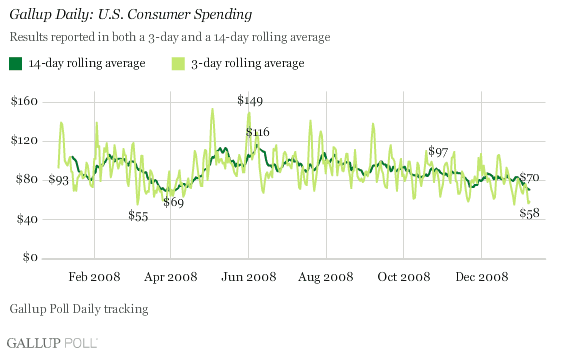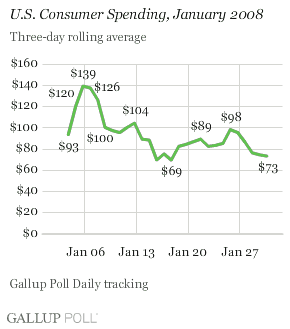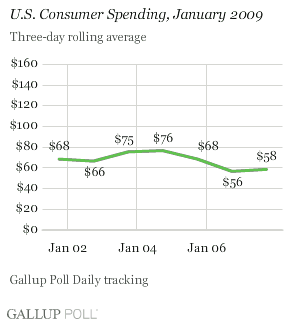PRINCETON, NJ -- Gallup's consumer spending measure has continued to slide as the new year has begun, with Americans spending a daily average of $58 across the three-day period of Jan. 6-8, one of the lowest amounts of the past year.

The trend of the Gallup Poll spending measure from Nov. 1 (roughly the beginning of the Christmas shopping season) through this past week reflects the various ups and downs one would expect. Average daily spending was at $97 for the first three days of November, followed by an increase about a week and a half into the month, a second increase in the days around Thanksgiving, and a final increase in December, about 10 days before Christmas. Since that time, the trends have been down, dropping to a not-unexpected low point of $55 between Dec. 22 and Dec. 27 (encompassing Christmas Day), with just a limited recovery in the days since. The $58 average for the three-day period of Jan. 6-8 is within a few dollars of the Christmas low point, which in turn matched the all-time low last March.
The daily average for the last 14 days is $70, the lowest such average since last April.
Gallup began measuring self-reported consumer spending at the beginning of last year. Spending was relatively robust as 2008 began, with three-day spending averages of at least $100 for a number of the days in the first half of the month.


Spending then settled back down, but the lowest three-day average of January 2008 was $69, still well above the current average of $58. Thus, the data from the first week of January this year suggest -- to no great surprise -- a continuation of the drop in consumer spending seen for most of 2008, and certainly a lower level of spending than was the case a year ago at roughly this same period of time.
Implications
Consumer spending is in many ways the core of the U.S. economy, and as consumers pull back on their spending, many sectors of the economy concomitantly falter. Gallup Poll Daily tracking data on the economy document the drop in spending that has occurred since the beginning of the summer, and the bad news is that the first indications of spending in the new year look equally if not more dismal.
Survey Methods
For the Gallup Poll Daily tracking survey, Gallup is interviewing no fewer than 1,000 U.S. adults nationwide each day during 2008. The consumer spending question is asked of a random half sample of each day's interviews, and for any given three-day rolling average of results, consisting of approximately 1,500 interviews, the maximum margin of sampling error is ±3 percentage points.
Results for the Jan. 6-8, 2009, rolling average are based on telephone interviews with 1,438 national adults, aged 18 and older. For results based on the total sample of national adults, one can say with 95% confidence that the maximum margin of sampling error is ±3 percentage points.
Interviews are conducted with respondents on land-line telephones (for respondents with a land-line telephone) and cellular phones (for respondents who are cell-phone only).
In addition to sampling error, question wording and practical difficulties in conducting surveys can introduce error or bias into the findings of public opinion polls.
